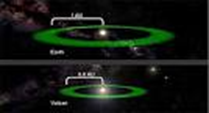Our night skies are scattered with several litted celestial bodies called "stars". Stars are giant, luminous spheres of plasma that are made up of helium and hydrogen. As you take a closer look into the sky, you will see that stars radiate different colours such as blue, yellow, white, orange, and even red. Stars also have distances between each other, and thus, they also radiate different levels of energy and have different sizes. Some stars shine brighter than others, some might appear larger and produce more light compared to small stars whose lights are very limited. However, no matter how different they look in our eyes. They still all appear as one whose presence make our existences more even brighter.
They're more than 20 types of Stars, but in this article we'll be looking into three types: Red Dwarf Stars, Yellow Stars, and Blue Giant Stars
Red Dwarf Stars
Red dwarf stars are stars which have smaller sizes compared to other stars. They also burn at a low temperature which gives them a long life-span of about 10 trillion years. Since they are small in size, the amount of light energy they produce is also small. Nearly 70% of the stars in the observable universe are Red Dwarf Stars; however, they cannot be seen easily by the naked eyes unless you look through binoculars. A typical example of a Red Dwarf Star is Proxima Centauri which is located near the Earth.
The following are the examples of Red Dwarf Stars: (from sources across the web)
Yellow Dwarf Stars
Yellow dwarf stars are stars which have medium sizes, they also burn at medium temperature as compared to other stars. Our sun, the heart of our solar system, is a yellow dwarf star. Yellow dwarf stars, however will become large as soon as they completely run out of fuel. Our sun in roughly 5 billion years from now, will exhaust the hydrogen fuel in its core and start burning helium, forcing it to transit into a red giant star.
The following are the examples of Yellow dwarf Stars: (from sources across the web)
Capella |
Sirius | Sun |
G-type |
Blue Giant Stars
Blue Giant Stars are stars which have the largest size
among other types of stars. They also burn at high temperatures which gives
them a short life-span of about 10,000 to 1,000,000 years. Since they are the
largest stars, they shine brighter in the night sky. Their big sizes make
them easier to see, and perhaps make them the most common stars in the sky.
Lastly, when the Blue Giant Stars are about to die, they explode and luminate
the whole sky! Tragic yet beautiful
The following are the examples of Blue Giant Stars: (from sources across the web)
Rigel |
UY Scuti |
Alnitak Aa |
Zeta Puppis |
Alnilam Surface temperature: 27,000 K |
Why do stars twinkle?
You might be wondering why stars twinkle, aren't you? Well, the
twinkling of stars known as the stellar scintillating, are caused by the
refraction of light as it passes through the Earth's Atmosphere, in which the starlight
undergoes refraction before it reaches the Earth. As the starlight travel
through the atmosphere, it passes through different levels of air which also
have different densities and temperatures, each of those layers of air refracts
the starlight which causes it to bend in different directions in every single
moment. Hence, stars do not twinkle at all; they're just bending and moving in
zigzag motion. What we see is all just an illusion!
Which are the coldest stars: blue or red?
Stars that appear blue tend to be the hottest stars, while the red stars
are the coolest ones. Yellow stars are hotter than red stars. White stars are
hotter than red and yellow. Their
hotness and coldness are being measured by the amount of heat they
produce
Humans Can’t Live Without Stars
Researchers have found that the presence of stars in the sky is of great importance to the lives of every human, they’re not just displayed as an
attraction. Stars are very important, because they serve as a source of energy
which humans need. Our Sun is a Star, and by the energy it produces, we are
able to get the warmth we need, for humans to survive, not just humans but all the
living things on Earth. Without the sun there would be no photosynthesis for
plant to make food. They may be some ways to live temporarily without the sun,
but it is impossible to maintain life on earth without it.
Do you know that the largest known star inhabiting in the universe is the UY Scuti Star? Yes that’s true! Uy Scuti Star was first catalogued in 1860 by German astronomers at the Bonn Observatory. Its radius is about 1.1883 billion km. Its surface temperature is about 3,365 K with a distance to Earth of 5,219 light years. Furthermore, it belongs to scutum constellation which is the 84th constellation size.
“Stars are sometimes alone and always linger in darkness, but that darkness gives them the opportunity to shine and give light to those people who seems hopeless.”
-Sarah Jane Sederiosa
Written by Sarah Jane Sederiosa






























